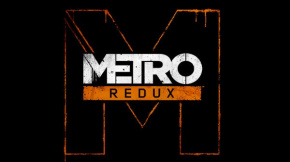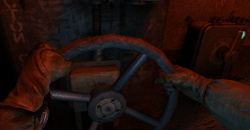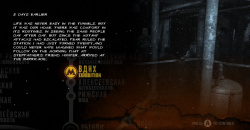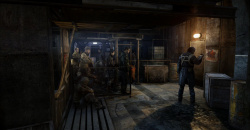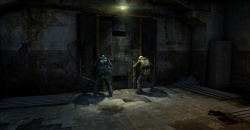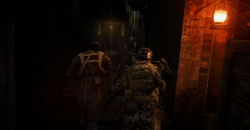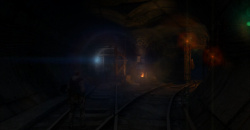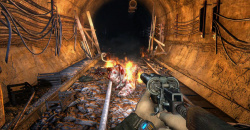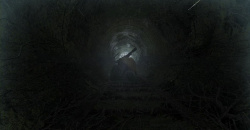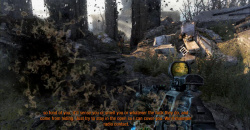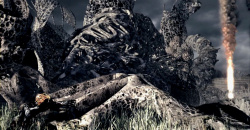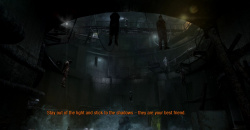There’s an eventful history behind the series of games based on the novel Metro 2033 by Dmitry Glukhovsky and its various sequels and spin-offs. Originally published by THQ, the brand was acquired by Deep Silver after THQ declared bankruptcy. In August, developers 4A Games, to the delight of next-gen console owners, released a compilation for Xbox One and PlayStation 4 containing both Metro 2033 and its sequel, Metro: Last Light in one box. As Metro Redux, the graphics have been nicely updated, and all available DLC and difficulty levels are included. We had a look at it so we could tell you whether it’s worth purchasing the new version or whether it’s just more of the same.
A light in the darkness
The Metro series takes place in a post-apocalyptic Russia following a nuclear holocaust, where the people of Moscow live underground, or more accurately, in the tunnels of the famous Moscow Metro. Nuclear radiation and fallout have rendered life on the surface impossible. Over time, different factions have emerged, fighting one another for control of the tunnels. On one side are the fascists of the “Fourth Reich”, who want to establish a totalitarian regime in the Metro tunnels. On the other side are resurgent Soviet Communists, who make up the largest faction in the game. And as if that were not enough, the tunnels are crawling with vicious mutant monsters, as well as the sinister “Dark Ones”, both of whom make the tunnels an even more dangerous place to call home. Despite all the perils they face, a few independent stations have managed to survive. Artyom, the series’ protagonist belongs to one of these independent communities.
Artyom inadvertently ends up on the front lines between the hostile factions, and spends both games fighting his way through warring enemy factions and feral mutants, until he is able to put an end to the Dark Ones once and for all. The Dark Ones are mutants who are so extremely advanced that they can contact humans telepathically and use this power to control them. Driven by strange fantasies and weird dreams, Artyom sets out on a long journey through the ruins of Moscow, a journey where he will more than once witness the very depths the human soul can reach, making him wonder who the real monsters here are.
The games really manage to capture the bleak world described in the novels and bring it to life. Life in the Metro tunnels is hard and without mercy, and the pervasive sense of melancholy is underscored well by the NPCs in various scenes. The series’ moral premise – that man is his own worst enemy – is never left in doubt, and the book series’ thinly-veiled critique of war is made quite visible in the game. It’s an absurd notion, but sadly familiar – although the world has been destroyed once already, human beings are still able to find reasons to wage war and to wipe each other out. By staying true to the books, the FPS game manages to draw players deeper into a very convincing world, and the result is one of the most intense gaming experiences of the past few years.
Gameplay is divided between combat and stealth sequences. In the course of his travels, Artyom often has to get past enemies, which can lead to some pretty fierce exchanges of fire. But in the world of Metro, ammo is not just a weapon, but also a currency. This means that Artyom is never free to just fire off rounds indiscriminately, but must always keep an eye on his “capital”. Fortunately for him, there are other ways out of most situations besides shooting his way out. Stealth is a tried and true method of saving ammo and reaching objectives without a fight. Unfortunately the stealth mechanics in Metro 2033 don’t work all that well, but more on this later.
Survival Ranger
Those for whom the dark and grim atmosphere is not enough have the option of making things a whole lot harder for themselves with the game’s higher difficulty levels. Survival mode from the first game is now available in the second, and Ranger mode from the second game is now available in the first. Survival Mode has tougher enemies and limits the amount of ammo and equipment you’ll find in the course of the game; i.e. it directly affects the game itself. Ranger Mode affects the meta-game, meaning that while it doesn’t affect the game itself in-universe, it does have an effect on how the player interacts with the game world and what can be seen on the screen. Ranger Mode does away with all the meters and indicators so common in FPS games; there’s no HUD, for example, and no messages telling you what button to press. There’s also no radar and no ammo meter. This adds an extraordinary amount of immersion to the game, but it also makes it a lot more difficult. For this reason, it’s really only for experienced players who are very familiar with the game and the controls. For intance, at the beginning of the game you’re told to put on a gas mask, requiring you to press a certain combination of buttons not found in the control options. Without any on-screen instructions, inexperienced players will face a baffling enigma, and just three minutes into the game, at that! Nevertheless, these extra modes add a lot of atmosphere and authenticity to the game, and they are just the right thing for any true fan of the Metro universe.
As mentioned above, all the additional DLC content from the two games is included in the new version. Along with all the cool extra weapons like the RPK Machine Gun and the “Abzats” Heavy Automatic Shotgun, Metro Redux includes the Faction Pack, the Tower Pack, the Developer Pack, and the Chronicle Pack. The Faction pack expands the game with the addition of three single-player chapters. The Tower pack features a combat simulator where you try to survive wave after wave of enemies in order to see how you fare against other players in an online ranking list. The Tower doesn’t really have anything to do with the plot of the game itself, however. The Developer Pack includes even more interesting content, such as a new chapter for the single-player campaign, a firing range, and offline death match arena, and a museum about the Metro universe. Last but not least, the Chronicle Pack expands the single-player mode with yet another plotline including new levels featuring Artyom’s companions Anna, Khan, and Pavel.
Bringing Metro into the next generation
They’ve done a really good job adapting the games for the newer consoles – there’s no loss of quality in the controls or graphics. Quite the opposite, in fact – the graphics are now at the high-end PC level, and with high-resolution textures and improved light and shadow effects, they’re really impressive. The control layout of the original games’ is something the programmers weren’t about to mess with, and so the controls for Metro Redux on PS4 and Xbox One are as smooth and intuitive as before. Unfortunately, they didn’t really do much with the AI, so enemies in Metro 2033 still know where to find you as soon as you’ve dispatched one of their comrades with a stealth kill. It’s a shame, because they could have taken the opportunity to get rid of one of that game’s real weaknesses. As expected, there haven’t really been any changes to the game’s soundtrack or sound effects. There really wasn’t any need for it though, as the soundtrack already did an excellent job of getting the game’s overall atmosphere across, and intensifying it when the plot called for it.
Official UK Lauch Trailer





